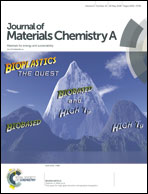Synthesis of MoS2 from [Mo3S7(S2CNEt2)3]I for enhancing photoelectrochemical performance and stability of Cu2O photocathode toward efficient solar water splitting†
Abstract
Cu2O is a typical p-type semiconductor that can efficiently absorb visible light and has a high absorption coefficient due to its narrow forbidden band. Thus, it finds potential applications in solar energy conversion and photocatalysis. However, Cu2O photocathodes suffer from a major issue of chemical stability and sluggish proton reduction for splitting water using sunlight. We present here a facile method of coating a thin MoS2 layer onto Cu2O to significantly improve its stability and proton reduction efficiency. MoS2 coating on top of Cu2O is achieved by spin coating a [Mo3S7(S2CNEt2)3]I precursor combined with a thermal annealing process to obtain the optimal stoichiometry. MoS2 thin films synthesized using this method show good prospects as both a protection layer and an electrocatalyst for hydrogen evolution reactions (HER) due to excellent stability and high electrocatalytic activity. The proton reduction performance of spin-coated MoS2/FTO electrodes is studied to determine the optimal synthesis conditions using various derivatives of MoS2 precursors. Our study suggests that the rate-limiting kinetic step of MoS2 synthesized in this method is the desorption of adsorbed hydrogen atoms to form molecular hydrogen, and that nanocrystalline MoS2 with copiously exposed S edges are more active for HER. Photoelectrochemical measurements demonstrate the highest activity for 3-layered (<40 nm thick) MoS2/Cu2O photocathode fabricated at 450 °C with a photocurrent density of ∼6.5 mA cm−2 at −0.2 V vs. RHE. Additionally, the MoS2 coating helps minimize the dark current of the Cu2O photocathode.
![Graphical abstract: Synthesis of MoS2 from [Mo3S7(S2CNEt2)3]I for enhancing photoelectrochemical performance and stability of Cu2O photocathode toward efficient solar water splitting](/en/Image/Get?imageInfo.ImageType=GA&imageInfo.ImageIdentifier.ManuscriptID=C8TA01771A&imageInfo.ImageIdentifier.Year=2018)


 Please wait while we load your content...
Please wait while we load your content...
